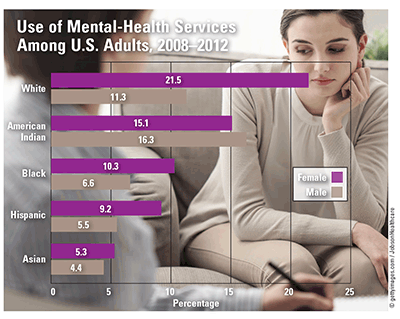US Pharm. 2018;43(11):46.
The 2016 National Survey on Drug Use and Health reported that 35 million people aged 18 years and older (14.4% of adults) received mental-health care. Based on their severity, mental-health illnesses are categorized as any mental illness (AMI) or serious mental illness (SMI). One in five adults has AMI, and nearly 63% of AMI cases progress to SMI. Despite effective treatment, there are prolonged delays between the appearance of symptoms and receipt of treatment.

AMI Treatment: Of adults with AMI, 19.2 million (43% of adults) received mental-health services. More women than men with AMI received mental-health treatment (48.8% vs. 33.9%). The percentage of individuals aged 18 to 25 years with AMI who received mental-health treatment was lower than that for persons aged 26 to 49 years and those aged 50 years and older (35.1%, 43.1%, and 46.8%, respectively). Use of mental-health services in adults with AMI was similar between whites and American Indians (46.3% vs. 41.6%) and between African Americans and Hispanics (29.8% vs. 27.3%). More whites with AMI (41%) used prescription medications compared with African Americans (23.4%) and Hispanics (22.4%). Whites (23.4%) used outpatient services more than African Americans (18.7%) or Hispanics (16.6%). Asian Americans with AMI used any mental-health services (18.1%), prescription medications (12.2%), or outpatient services (11%) the least. The extent of use of inpatient mental-health services by adults with AMI was similar among Hispanics (3.2%), whites (2.9%), and Asian Americans (2.5%) and higher in African Americans (5.1%).
SMI Treatment: Among adults with SMI, 6.7 million (64.8%) received mental-health treatment; of these, 68.8% were women and 57.4% were men. More whites (67.9%) than Hispanics (61.6%) and African Americans (56.8%) received treatment. The percentage of persons aged 18 to 25 years with SMI (51.5%) who received treatment was lower than that in persons aged 26 to 49 years (66.1%) and aged 50 years and older (71.5%). Prescription-medication use was highest in whites (14.4%), followed by American Indians (13.6%), African Americans (6.5%), Hispanics (5.7%), and Asian Americans (3.1%).
Treatment Compliance: Types of treatment included health professional only, medication only, and combined health professional and medication. Combined health professional and medication (44%) was the most common mode of treatment; medication-only treatment was least often used (6%). Approximately 37% of adults with major depressive episodes did not receive treatment, according to the Substance Abuse and Mental Health Services Administration. Approximately 60% of mentally ill adults did not receive mental-health services in 2016. Compared with whites who sought mental-health services, fewer African Americans (50%), Hispanics (50%), and Asian Americans (33%) sought these services.
To comment on this article, contact rdavidson@uspharmacist.com.






